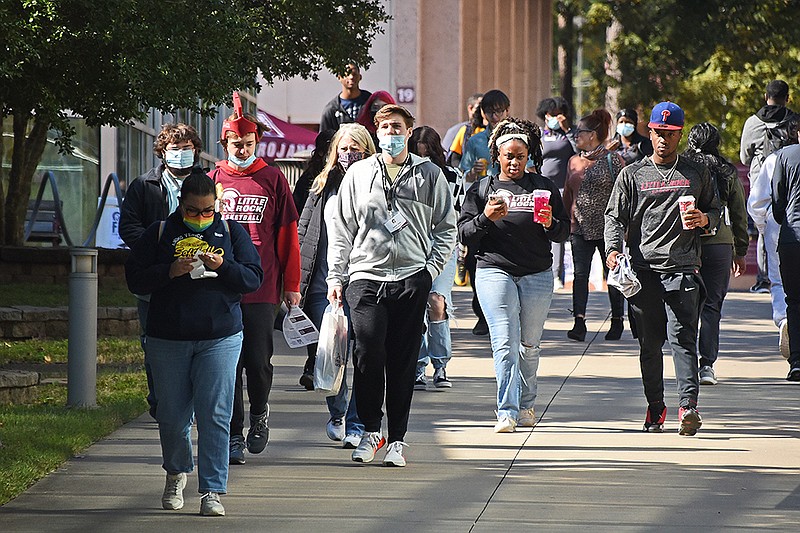The University of Arkansas at Little Rock hit an enrollment slump in recent years, but a rising proportion of first-year students are coming from outside the state and the school is looking to hire a Texas-based recruiter.
This past fall, out-of-state students made up 19% of UALR's incoming freshman class, according to self-reported data, up from 10% four years earlier.
Chancellor Christina Drale referred to "returns on investment" in response to a question from the Democrat-Gazette. A 56-page Strategic Enrollment Management Plan for UALR put together in 2019 made no mention of boosting the number of out-of-state students.
"Our recruitment strategies are guided by data-driven projections of the best returns on investment within the parameters of our institution's role and scope," Drale said in a written statement. The strategic enrollment plan's objectives "are not restricted or delineated by geographical area," she said.
This past fall, UALR enrolled 19 Texans as first-year students, plus 21 new transfer students from Texas, according to data provided by the university to the Democrat-Gazette. In total, 481 first-time, first-year students enrolled at UALR this past fall, according to self-reported information on the university's Common Data Set.
In an advertisement published earlier this month, UALR stated that it is seeking a regional admissions counselor based in the Dallas/Fort Worth area, sometimes referred to as the DFW. The stated salary for the position is $50,000, according to the ad.
UALR, the fifth-largest university in the state, "is known in the community as the place for non-traditional students," as stated in the university's strategic enrollment plan. The plan goes on to state that students who are parents or work full-time or did not enroll in college right out of high school need extra support.
The university also enrolls greater numbers of Black students than any of the state's six largest public universities, and, compared to those same six universities, its transfer enrollment is greater than all except the University of Arkansas at Fayetteville, according to federal data.
But UALR has seen total enrollment decline by 28.6% since 2017, with its number of students falling to 8,295 this past fall compared with 11,624 in fall 2017, according to data from the state Division of Higher Education. A majority of public universities in Arkansas have also seen enrollment declines, but none steeper than at UALR.
In 2020, the University of Arkansas board of trustees approved a restructuring plan that reduced the university's colleges to three from five and cut some academic offerings. As part of the restructuring, the board last year formally eliminated the university's Bachelor of Fine Arts dance degree program, for example.
The 56-page strategic plan for UALR for 2020-25 stated that the university "attracts over 65% of our freshman class from central Arkansas," going on to describe the importance of local relationships.
"Due to this large population, many of our recruiting efforts will focus on area high schools and community partners. We will continue to build relationships in the community with area stakeholders," the 2019 report stated.
Drale, in her statement to the Democrat-Gazette, referred to in-state recruitment efforts and also student "demand" existing elsewhere.
"Most of our recruitment efforts are focused within Arkansas, but in certain areas where we see evidence of demand outside of state borders -- for instance, for online programs, graduate programs and certain high-demand undergraduate fields -- we may expand our recruitment reach using strategic and targeted methods," Drale said.
The ad for the regional admissions counselor states that the new hire "will be responsible for managing the University's undergraduate student recruitment efforts in an assigned territory and other areas as designated."
Job duties are to include visiting "high schools and community colleges to recruit students," as well as working "college fairs" and "college-day events."
The state's largest university, UA-Fayetteville, has seen enrollment growth driven by rising numbers of out-of-state students, especially from Texas. In Fayetteville, roughly 55% of the incoming freshman class of about 6,000 this past fall came from outside the state.
UA-Fayetteville has academic recruiters based in various locations outside the state, including in the Dallas area.
Like UA-Fayetteville, UALR offers a grant program called the New Arkansan Non-Resident Tuition Award.
At UALR, the New Arkansan award offsets by 90% the difference between in-state and out-of-state tuition for students who meet certain academic requirements, according to the university's website. To qualify, incoming UALR students must have at least a 3.0 high school grade-point average and at least a 20 ACT score, according to UALR's website.
Carrie Phillips, a university spokeswoman, said UALR has offered a New Arkansan tuition award since 2013. Like at UA-Fayetteville, no separate scholarship application is required to be considered for the award.
UALR's website lists a total of six academic recruiters already working within the university's admissions office. Each has responsibilities inside Arkansas, but some are also listed as shouldering additional responsibilities to recruit outside the state.
Phillips, in an email, said the university "is piloting a new position" housed in the Dallas area.
"It is somewhat typical for universities to place recruiters out-of-state in large market territories," Phillips said. "DFW was selected because of the projected high school graduation population, North Texas' proximity to UA-Little Rock and the uptick in interest we've seen from prospective students."
Travel time by car between Little Rock and Dallas is roughly four-and-a-half hours.
Phillips added that "Arkansas remains the focus area" for recruitment, "with most enrolling students coming from Pulaski and contiguous counties."
Asked if the university has set a numeric goal for recruiting out-of-state students, Phillips said no target percentage has been set.
Despite the previous years of slumping enrollment, Phillips said some growth is expected this fall.
"Based on current enrollment figures, UA-Little Rock expects an increase in both freshmen and transfer students for fall 2022," Phillips said.
